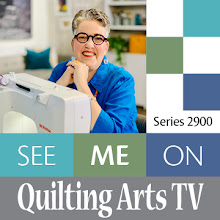I didn’t too much thread sketching done on this piece today, but it is starting to take shape. I started by outlining the sections on the main pumpkin in the foreground with black. Then I added some yellow on the parts of the sections that are the lightest – the highlights. I’m not sure if they are light enough yet.
I added white thread on the areas where the pumpkin had some warty, lumpy blemishes.
I want to blend the area where the orange of the pumpkin fades into the deep shadow. I’ve already added some sage green there, and will go back in with some oranges, too. You might not be able to see much of the green thread in these photos, as the lighting conditions were kind of dark.
I’ve started to add some shadows to define the segments on the green-gray pumpkin.
I am wondering if I should sketch in the boards on the wall behind the pumpkins. It kind of looks like a dark October sky, and I am liking it. I could just quilt the sky to suggest clouds and keep it simple. If you have an opinion, let me know what you think.






























































